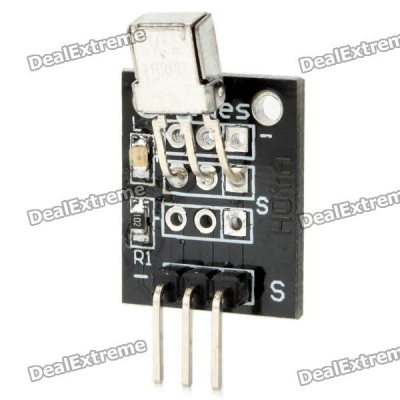Arduino KY-022 Infrared sensor receiver module
From
Contents
Infrared remote control module
Infrared controller (in other TkkrLab Arduino Set)
This is a new ultra-thin 38K universal infrared remote control, using the NEC encoding format, mainly for cars Containing MP3, foot bath, lighting design equipped, digital photo frame, microcontroller development board learning board and other occasions. Because it is based on non-Line remote control, so people seem easy to use, effective, and now more and more wide application field, then for This product of our company that we will make the following introduction.
Specifications
- Infrared remote control distance: more than 8 meters
- Launch tube infrared wavelength: 940Nm
- Crystal frequency: 455KHZ crystal
- Carrier frequency: 38KHZ
- Encoding: encoding format for the NEC
- Size: 86 * 40 * 6mm
- Power: CR2025/1600mAH
Use
Remember that the remote control and the ir receiver is a set, it has to decode the code and will display a hex code.
Test
- Arduino controller × 1
- USB data cable × 1
- Infrared remote control × 1
- the infrared receiver module × 1
Schematic
- Arduino GND --> Module pin -
- Arduino +5V --> Module PLUS (middle pin)
- Arduino Digital pin 11 --> Module S
Example Code
This is the supplied demo code for the Arduino you can find under File->Examples->IrRemote->IrRecvDemo
/* * IRremote: IRrecvDemo - demonstrates receiving IR codes with IRrecv * An IR detector/demodulator must be connected to the input RECV_PIN. * Version 0.1 July, 2009 * Copyright 2009 Ken Shirriff * http://arcfn.com */ #include <IRremote.h> int RECV_PIN = 11; IRrecv irrecv(RECV_PIN); decode_results results; void setup() { Serial.begin(9600); irrecv.enableIRIn(); // Start the receiver } void loop() { if (irrecv.decode(&results)) { Serial.println(results.value, HEX); irrecv.resume(); // Receive the next value } }
Raspberry Pi2
Tutorial
Wiring the pi with the module
- left pin (GND) to pin 6 (GND)
- Center pin (VCC) to pin 1 (3,3V)
- Right pin (DATA) to pin 12 (GPIO 18)
Setting up Raspbian
Before running any code, install LIRC with sudo apt-get install lirc and the follow the prerequisites below
edit /etc/modules and add the lines below:
- lirc_dev
- lirc_rpi gpio_in_pin=18 gpio_out_pin=17
edit /etc/lirc/hardware.conf and modify to add the correct values as below:
- DRIVER="default"
- DEVICE="/dev/lirc0"
- MODULES="lirc_rpi"
edit /boot/config.txt and edit the dtoverlay value like this:
- dtoverlay=lirc-rpi,gpio_in_pin=18,gpio_out_pin=17,gpio_in_pull=up
reboot your pi
after reboot:
- stop lirc daemon: sudo /etc/init.d/lirc stop
- test your ir receiver by running: mode2 -d /dev/lirc0 then by pushing any key on your remote to see if something happens (random numbers)
your ir receiver is working !

